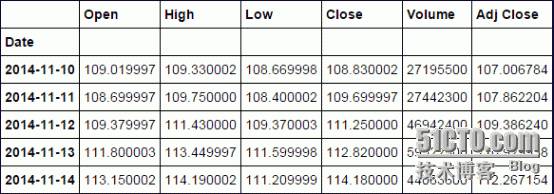
数据挖掘入门与实战 公众号: datadw
对于股票的研究我想,无论是专业人士还是非专业人士都对其垂涎已久,因为我们都有赌徒的心态,我们都希望不花太多的时间但是能赚足够的钱,而股票绝对是一个好的选择,本人也不例外对股票垂涎已久,不管你是否承认股票是一个来钱快的地方,但是伴随着的当然是巨大的风险,毕竟这么多炒股,并不是每个人都赚到了钱,下面的内容也不一定保证你一定能赚到钱,反正都是“猜”,不如让“猜”看起来更加专业一些。
原文章参考:http://nbviewer.ipython.org/github/jmportilla/Udemy-notes/blob/master/Data%20Project%20-%20Stock%20Market%20Analysis.ipynb
首先当然是导入我们需要的模块了
|
1
2
3
4
5
6
7
8
9
10
11
12
|
import
pandas as pd
from
pandas
import
Series,DataFrame
import
numpy as np
import
matplotlib.pyplot as plt
import
seaborn as sns
sns.set_style(
"whitegrid"
)
%
matplotlib inline
from
pandas.io.data
import
DataReader
from
datetime
import
datetime
from
__future__
import
division
|
注:其实国内的股票相关行情可以通过tushare这个库获取,但是碍于自己已经对着原文自己演练了一遍了,图都已经截好了,也就没有将股票中国化,分析的主要是AAPL,GOOG,MSFT,AMZN,数据来自Yahoo,在我自己的视频中我会带着大家一起获取国内的行情以进行演练的。
tushare相关信息参考:
http://tushare.waditu.com/
|
1
2
3
4
5
6
7
8
9
10
|
stock_lis
=
[
"AAPL"
,
"GOOG"
,
"MSFT"
,
"AMZN"
]
end
=
datetime.now()
start
=
datetime(end.year
-
1
,end.month,end.day)
for
stock
in
stock_lis:
globals
()[stock]
=
DataReader(stock,
"yahoo"
,start,end)
|
看看前面五条信息


DatetimeIndex: 252 entries, 2014-11-10 00:00:00 to 2015-11-09 00:00:00
Data columns (total 6 columns):
Open 252 non-null float64
High 252 non-null float64
Low 252 non-null float64
Close 252 non-null float64
Volume 252 non-null int64
Adj Close 252 non-null float64
dtypes: float64(5), int64(1)
memory usage: 13.8 KB
画一下每日调整收盘价的走势图
注:每日收盘价http://baike.baidu.com/link?url=plkht9HaMdpNPI2lFUsUvgYhjdYvqOlSStjrDvqQxhuHuA5Iaww_FVitVXEqp_ne0DATpwtuBKeSUPK8I1t4ka
|
1
|
AAPL[
"Adj Close"
].plot(legend
=
True
,figsize
=
(
10
,
4
))
|

|
1
2
|
AAPL[
"Volume"
].plot(legend
=
True
,figsize
=
(
10
,
4
))
|

下面两个链接有关移动平均线的一些说明
1.)
http://www.investopedia.com/terms/m/movingaverage.asp
2.)
http://www.investopedia.com/articles/active-trading/052014/how-use-moving-average-buy-stocks.asp
当然也可以瞧瞧百度百科:
http://baike.baidu.com/view/7973.htm
注:在tushare这个模块里获取的国内行情的相关信息就已经包揽了常用的均线了,非常赞!
参考:http://tushare.waditu.com/trading.html
import tushare as tsts.get_hist_data('600848') #一次性获取全部日k线数据
结果显示:
open high close low volume p_change ma5 \
date
2012-01-11 6.880 7.380 7.060 6.880 14129.96 2.62 7.060
2012-01-12 7.050 7.100 6.980 6.900 7895.19 -1.13 7.020
2012-01-13 6.950 7.000 6.700 6.690 6611.87 -4.01 6.913
2012-01-16 6.680 6.750 6.510 6.480 2941.63 -2.84 6.813
2012-01-17 6.660 6.880 6.860 6.460 8642.57 5.38 6.822
2012-01-18 7.000 7.300 6.890 6.880 13075.40 0.44 6.788
2012-01-19 6.690 6.950 6.890 6.680 6117.32 0.00 6.770
2012-01-20 6.870 7.080 7.010 6.870 6813.09 1.74 6.832
ma10 ma20 v_ma5 v_ma10 v_ma20 turnover
date
2012-01-11 7.060 7.060 14129.96 14129.96 14129.96 0.48
2012-01-12 7.020 7.020 11012.58 11012.58 11012.58 0.27
2012-01-13 6.913 6.913 9545.67 9545.67 9545.67 0.23
2012-01-16 6.813 6.813 7894.66 7894.66 7894.66 0.10
2012-01-17 6.822 6.822 8044.24 8044.24 8044.24 0.30
2012-01-18 6.833 6.833 7833.33 8882.77 8882.77 0.45
2012-01-19 6.841 6.841 7477.76 8487.71 8487.71 0.21
2012-01-20 6.863 6.863 7518.00 8278.38 8278.38 0.23
这里的平均线是通过自定义函数,手动设置的,主要是10,20,50日均线
|
1
2
3
4
5
6
|
ma_day
=
[
10
,
20
,
50
]
for
ma
in
ma_day:
column_name
=
"MA for %s days"
%
(
str
(ma))
AAPL[column_name]
=
pd.rolling_mean(AAPL[
"Adj Close"
],ma)
|
瞧瞧效果

默认subplots这个参数是False的,这里我们瞧瞧True的情况
|
1
|
AAPL[[
"Adj Close"
,
"MA for 10 days"
,
"MA for 20 days"
,
"MA for 50 days"
]].plot(subplots
=
True
)
|

|
1
|
AAPL[[
"Adj Close"
,
"MA for 10 days"
,
"MA for 20 days"
,
"MA for 50 days"
]].plot(figsize
=
(
10
,
4
))
|
很好看有没有!!!

让我们新建一个字段叫做“Dailly Return”,注意Dailly其实我写错了,Dailly Return其实是每日较于前一日的涨幅率.
|
1
2
3
|
AAPL[
"Dailly Return"
]
=
AAPL[
"Adj Close"
].pct_change()
AAPL[
"Dailly Return"
].plot(figsize
=
(
10
,
4
),legend
=
True
)
|

|
1
2
|
AAPL[
"Dailly Return"
].plot(figsize
=
(
10
,
4
),legend
=
True
,linestyle
=
"--"
,marker
=
"o"
)
|

|
1
2
|
sns.kdeplot(AAPL[
"Dailly Return"
].dropna())
|

注:This function combines the matplotlib
hist
function (with automatic calculation of a good default bin size) with the seaborn
kdeplot()
and
rugplot()
functions.
由官方说明可知,displot函数是由直方图与seaborn的核密度图以及rugplot(
Plot datapoints in an array as sticks on an axis.
)组合
|
1
2
|
sns.distplot(AAPL[
"Dailly Return"
].dropna(),bins
=
100
)
|

|
1
2
3
|
closing_df
=
DataReader(stock_lis,
"yahoo"
,start,end)[
"Adj Close"
]
closing_df.head()
|

|
1
2
3
|
tech_rets
=
closing_df.pct_change()
tech_rets.head()
|

AAPL 0.000456
AMZN 0.003203
GOOG 0.001282
MSFT 0.000623
dtype: float64
我们来瞧瞧jointplot这个函数,通过这个函数我们可以画出两个公司的”相关性系数“,或者说皮尔森相关系数(http://baike.baidu.com/view/3028699.htm),如下图所示
如果你看过《大数据时代》这本书,你就会知道为什么作者会求两个公司的相关性了,书中有提到的一个观点是,在大数据时代的到来,我们可以通过大数据来描绘事物之间的相关性并预测,而为什么,是后面要研究的事,注重相关性而不是因果关系。(个人读后感,如有偏驳还望指正)
下面这一部分主要在说相关性~
|
1
|
sns.jointplot(
"GOOG"
,
"GOOG"
,tech_rets,kind
=
"hex"
)
|

如上图所示,我们画出的事google与google自己的皮尔森相关系数,当然是1啦!值得说明的皮尔森相关系数的值在-1到1之间,1代表正相关,-1代表负相关,0代表没有任何相关性,有兴趣了解怎么算的,参考:https://en.wikipedia.org/wiki/Pearson_product-moment_correlation_coefficient
|
1
|
sns.jointplot(
"GOOG"
,
"GOOG"
,tech_rets,kind
=
"scatter"
)
|

注:上面两张图画的是同一件事物,不过我们kind指定的不同,分别是六边形hex,散点scatter
我们再来画画Google与微软的皮尔森相关系数吧
|
1
|
sns.jointplot(
"GOOG"
,
"MSFT"
,tech_rets,kind
=
"scatter"
)
|

下面是一些相关知识,有兴趣可以点击瞧瞧
如何计算协方差:
http://zh.wikihow.com/%E8%AE%A1%E7%AE%97%E5%8D%8F%E6%96%B9%E5%B7%AE
如何计算百分比变化:
http://zh.wikihow.com/%E8%AE%A1%E7%AE%97%E7%99%BE%E5%88%86%E6%AF%94%E5%8F%98%E5%8C%96
什么是
Pearson product-moment
:
https://en.wikipedia.org/wiki/Pearson_product-moment_correlation_coefficient
我们再来瞧瞧pairplot这个函数吧,四个公司的行情一起比较。
官方说明:
Plot pairwise relationships in a dataset.
By default, this function will create a grid of Axes such that each variable in
data
will
by shared in the y-axis across a single row and in the x-axis across a
single column. The diagonal Axes are treated differently, drawing a plot
to show the univariate distribution of the data for the variable in
that column.
It is also possible to show a subset of variables or plot different variables on the rows and columns.
该函数用于成对的比较不同数据集之间的相关性,而对角线则会显示该数据集的直方图,详情见下图呗,一图抵前言
至于从形态看出相关性,你可能得看看Wikipedia了
|
1
|
sns.pairplot(tech_rets.dropna())
|

再来瞧瞧Pairplot这个对象
|
1
2
3
|
returns_fig
=
sns.PairGrid(tech_rets.dropna())
returns_fig.map_diag(plt.hist,bins
=
30
)
|

|
1
2
3
4
5
6
7
8
9
10
11
|
returns_fig
=
sns.PairGrid(tech_rets.dropna())
returns_fig.map_upper(plt.scatter,color
=
"purple"
)
returns_fig.map_lower(sns.kdeplot,cmap
=
"cool_d"
)
returns_fig.map_diag(plt.hist,bins
=
30
)
|

再瞧瞧corrplot这个函数,官方我也敲不到它的说明,主要画相关系数,如下
|
1
2
|
sns.corrplot(tech_rets.dropna(),annot
=
False
)
|

|
1
|
sns.corrplot(tech_rets.dropna(),annot
=
True
)
|
在下面这一部分主要说风险这一部分了,比如推测最多亏多少钱~~
首先瞧瞧各数值吧
|
1
2
3
4
|
rets
=
tech_rets.dropna()
rets.mean()
|
AAPL 0.000456
AMZN 0.003203
GOOG 0.001282
MSFT 0.000623
dtype: float64
AAPL 0.016738
AMZN 0.021165
GOOG 0.018484
MSFT 0.017800
dtype: float64
|
1
2
3
4
5
6
7
8
9
10
11
12
13
14
15
16
|
area
=
np.pi
*
20
plt.scatter(rets.mean(),rets.std())
plt.xlabel(
"Expected Return"
)
plt.ylabel(
"Risk"
)
for
label,x,y
in
zip
(rets.columns,rets.mean(),rets.std()):
plt.annotate(
label,
xy
=
(x,y),xytext
=
(
50
,
50
),
textcoords
=
"offset points"
,ha
=
"right"
,va
=
"bottom"
,
arrowprops
=
dict
(arrowstyle
=
"-"
,connectionstyle
=
"arc3,rad=-0.3"
))
|
由上面我们可以看出AMZN亚马逊的预计收益要高于其他三家公司,但是风险值也要高于其他三家公司~这是怎么看出来的呢?
摘自百度百科(http://baike.baidu.com/view/78339.htm):在投资基金上,一般人比较重视的是业绩,但往往买进了
近期业绩表现最佳的基金之后,基金表现反而不如预期,这是因为所选基金波动度太大,没有稳定的表现。
衡量基金波动程度的工具就是标准差(Standard Deviation)。标准差是指基金可能的变动程度。标准差越大,基金未来净值可能变动的程度就越大,稳定度就越小,风险就越高
而期待收益值就是我们在上面说到过的每日涨幅度,这四家公司近一年而言每日的更改幅度的平均值都是大于零的,说明至少是涨着的。
而怎么标出图上的效果参考下面matplotlib的官方说明
Matplotlib
的注释详情参考:
http://matplotlib.org/users/annotations_guide.html
如何计算标准差:
http://zh.wikihow.com/%E8%AE%A1%E7%AE%97%E5%9D%87%E5%80%BC%E3%80%81%E6%A0%87%E5%87%86%E5%B7%AE%E5%92%8C%E6%A0%87%E5%87%86%E8%AF%AF%E5%B7%AE
什么是标准差,及其意思:
http://baike.baidu.com/link?url=XOhnnn6npvQejz5raELJIvSLYxJZV75w1Gxf4DqRajcqWNzhhTFi7rbkoOQnBzEVtg8_GWdfamnrSM0sooBoQa
摘录:
标准差应用于投资上,可作为量度回报稳定性的指标。标准差数值越大,代表回报远离过去
平均数
值,回报较不稳定故风险越高。相反,标准差数值越小,代表回报较为稳定,风险亦较小。
蒙特卡洛评估
在应用蒙特卡洛评估之前,先看看这些股票的基本。
|
1
|
sns.distplot(AAPL[
'Dailly Return'
].dropna(),bins
=
100
,color
=
'purple'
)
|
再来瞧瞧Quantile,这个我也没太看懂,什么置信区间,如有了解还望指教
什么是百位分数参考:
http://www.itongji.cn/article/0ZRJ52013.html
|
1
|
rets[
'AMZN'
].quantile(
0.05
)
|
-0.021360026714234592
上面的结果说明,我们95%的置信,一天我们不会损失超过0.02160...
|
1
2
3
4
5
6
7
8
9
10
|
days
=
365
dt
=
1
/
days
mu
=
rets.mean()[
"GOOG"
]
sigma
=
rets.std()[
"GOOG"
]
np.random.normal(loc
=
0
,scale
=
1
)
1.294219218586235
|















